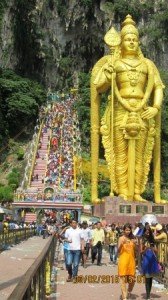The south Indians in Malaysia celebrate the annual Thaipusam festival in all major towns of the country where there is a Murugan temple. In Kuala Lumpur, it is in Batu Caves, which attracts most pilgrims and tourists. The temple complex in Batu caves is a tourist attraction, now a heritage site of Malaysia. The Batu Caves is one of the most popular Hindu shrines outside India, dedicated to Lord Murugan; it is also the focal point of the Hindu festival of Thaipusam. It is said that, in India, the Thaipusam festival is more visible in the Sri Dhandayuthapani temple in Palani town of district Dindigul in the state of Tamil Nadu, which is about 100 Km North West of Madurai city. Lord Murugan is also known by the names of Kartikeya, Subramanya and Mariamman.
The festival commemorates the occasion when Parvati gave Murugan a spear/lance to vanquish the evil demon Soorapadam. The Kavadis are carried in fulfilment of vows and pledges taken in devotion to god. It is a day of penance and spiritual cleansing when devotees can be seen with metal hooks, spikes, trident/trishul pierced through their body, skin, cheeks and tongue.
The kavadis are of many types and decorations from simple wooden arched semi-circular supports holding a carrier foisted with brass or clay pots of milk. The kavadi is decorated with flowers, peacock feathers and a photo or statue of the Lord Murugan.
The Thaipusam festival procession begins in the wee hours of the morning from the Sri Mahamariamman Temple, situated in the heart of the capital Kuala Lumpur leading up to Batu Caves which is about 14 Km from the city temple. In earlier days the decorated wooden chariot was pulled by bulls, but since 1983, it is a 21 feet silver chariot which is mechanically pulled.
The tallest Lord Murugan statue in the world was unveiled at Batu Caves in January 2006. The 42.7 metre (140 ft) statue took three years to construct. Made of 1550 cubic metres of concrete, 250 tonnes of steel bars and 300 litres of gold paint, it is the second tallest statue of a Hindu deity in the world, only second to the Kailashnath Mahadev statue in Nepal.
In 1878, K Thamboosamy Pillai, an Indian trader, promoted Batu Caves as a place of worship as he was inspired by the ‘vel’-shaped entrance of the main cave, dedicating a temple to Lord Murugam within the caves. Since 1891, the Thaipusam festival in the Tamil month of Thai (which falls in late January/early February) has been celebrated at Batu Caves. 3 February 2015 marked 125 years of Thaipusam celebrations.
In 1920, the wooden steps up to the Temple Cave were built, later replaced by 272 concrete steps in 1940. The Temple or Cathedral Cave, so named because it houses several Hindu shrines beneath its high vaulted ceiling is the largest and the best known. The temple complex consists of three main caves and a few smaller ones. The Cathedral Cave or Temple Cave, has a very high ceiling and features ornate Hindu shrines. The Art Gallery Cave and Museum Cave, both of which are full of Hindu statues and paintings are at the base of the hill. In the year 2008, this complex was renovated and opened as the Cave Villa. The Ramayana Cave is situated to the extreme left as one faces the sheer wall of the hill. On the way to the Ramayana Cave, there is a 50-foot (15 m) tall statue of Hanuman and a temple dedicated to Hanuman. Along the irregular walls of the cave the story of Rama is depicted in a chronically.
The annual Thaipusam festival is a grandiose affair and has become a pilgrimage site not only for Malaysian Hindus, but also for Hindus from many other countries. It is a tourist attraction and never-to-be-missed occasion in Malaysia. The Batu Caves boasts millions of visitors during Thaipusam, which is a public holiday in several states and territories in the country. The rituals take place over three days and the spirit of festivity is enjoyed by people of all faiths in the country.
The Author contacted at email- swagroy@hotmail.com



